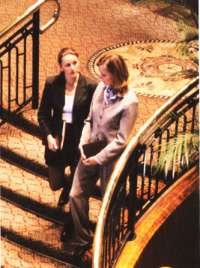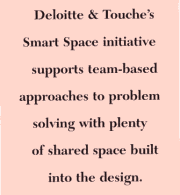The stature of the workspace design industry is rising significantly thanks to renewed interest in designers’ ability to make office space and other work environments more productive — not just easier to look at. Speakers at a recent forum in New York, entitled “Measuring Workplace Performance — The Workplace at the Millennium,” shared their experiences of designing work environments to maximize performance and productivity. The first part of this report, “Design Experts Shed Light on Workplace Performance Measures,” appeared in the July 2000 issue of Site Selection.
During a recent period of rapid growth, Deloitte & Touche managers decided to rethink the firm’s workspace effectiveness in light of the fact that about 300 employees had no workstation of their own, and yet as much as 40 percent of the workspace was vacant at any one time. A committee of managers was formed representing human resources, information technology, real estate, audit, client support, the regional managing partner and others. Their assignment was to identify ways to enhance client service and maximize workspace by designing it in such a way that employees can perform their work from wherever it makes the most sense to do so. The result is a work environment known as Smart Space, noted Stephen Silverstein, director of real estate, facilities and adminstration at Deloitte & Touche, who participated in the planning of the concept.
“We need to provide an environment that allows people to work anywhere, anytime,” says Silverstein. “If that means they are in the office, then we support them there. They may be with a client, at another Deloitte & Touche office, and we support them there [with remote technology].”

Space has been reconfigured to de-emphasize offices and to focus more on providing space in which to reorient oneself after or between client meetings. The concept actually encourages greater client contact with enhanced client-support facilities in which to meet with clients and tools for working outside the traditional office environment. Additionally, it supports team-based approaches to problem solving with plenty of shared space built into the design.
“Smart Space gives us the opportunity to align the architecture and the technology with the business needs of the client service professionals in the region,” observes an executive of the firm who is quoted in a video about the concept. Adds another: “We want to be the employer of choice and to provide the best [work-related resources] in the region, so the initiative is more of a business strategy, not just a real estate strategy.”
Value in Partnerships
Rick Focke, senior principal and director of design at HOK Consulting, noted that his firm works with three types of clients: the educated client, the client who wants to be educated and the client who just wants the job done quickly and economically. All clients share the priority of attracting and retaining employees and providing them the collaborative, shared spaces they require.
Focke says HOK takes its client partnerships seriously, and in the case of one client, Nortel Networks, measures the productivity of each project. “It’s an open-book platform with Nortel, where we go through the numbers and they know what the fees are, they know what our profit is, what their measurements are. Nortel is very involved in its workplace.”
Partnering with clients is “more realistic” today, notes Focke, because clients now look to their service providers to help them set strategic goals and objectives. “Design is coming on strong again in that context,” he added. Among HOK’s clients are Sun Microsystems, Nissan and AT&T.
The program’s final speaker was Eileen Harvard, director of workplace strategies and solutions at Citibank, who considers herself more than familiar with the notion of change management. Harvard is a veteran of two major bank mergers. “Designers are catalysts for change,” she noted. “I started my career as a designer, but I decided that the ultimate revenge was to become a client, and I did that in the mid-1980s. So my perspective is almost that of a translator, being inside these companies and some of the things I see.”
 A New World View Unfolds
A New World View Unfolds
Driving the rapid rate of change in this era of electronic commerce is the higher employment, importance of speed-to-market and the half-life of technology, says Harvard. “So you want to maximize resources used for the core business, which is an interesting concept. At Citi,” she continued, “we are shedding everything that is not our core business, which is an opportunity for people in the design market and all the construction markets. Developers will be much more responsive to the kind of basic research that has been presented at this form about performance measurement and effectiveness over time.”
The way real estate is viewed is evolving, Harvard pointed out. Hoteling solutions, such as Deloitte & Touche’s Smart Space, are examples of how new approaches to design are in demand. And more corporations, including Citi, have shorter-term views of their real estate needs. “Frankly, we don’t look 15 years out for a building any more, and Citi is not developing for its own portfolio now,” noted Harvard. “And I don’t think you’ll see many other corporations do that, either.”
Harvard cited a passage from the motivational book, “Who Moved My Cheese?” by Spencer Johnson, M.D., (G.P. Putnam’s Sons, 1998, New York), concerning the importance of flexibility. It reads: “While in the past we may have wanted loyal employees, today we need flexible people who are not possessive about the way things are done around here.” Which is exactly what happens in mergers, noted Harvard. “That same flexibility is beginning to promote less ownership of workspace, which is letting shared workspace work.”
The challenge for the design community is to simplify the process so that it can accommodate change, because businesses change in the time it takes to design and build space.

